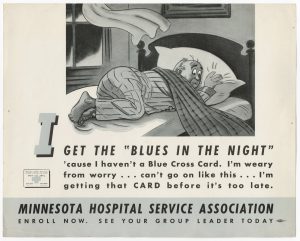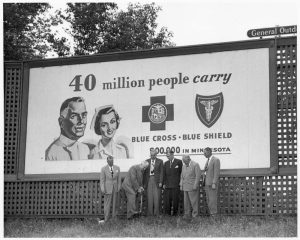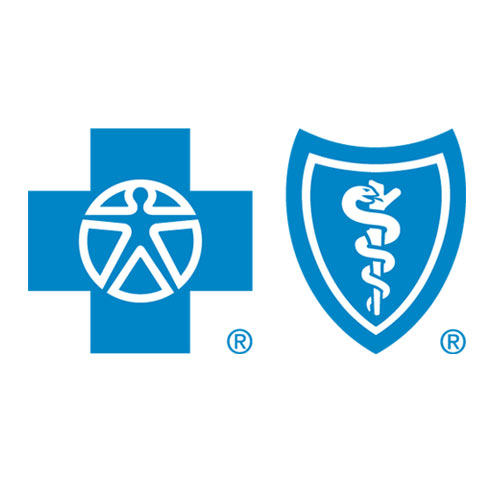The origins of Blue Cross in Minnesota: A story 90 years in the making
February 4, 2023From the beginning, Blue Cross and Blue Shield of Minnesota established itself as an innovator. Over the years, we’ve forged a path of continuous change in healthcare. Now, we are proud to be celebrating our 90th anniversary.
 The organization that would come to be known as Blue Cross got its start on February 4, 1933, when seven hospitals in St. Paul formed the Hospital Service Association (HSA), creating the first healthcare organization in the United States to offer a prepaid network for medical care.
The organization that would come to be known as Blue Cross got its start on February 4, 1933, when seven hospitals in St. Paul formed the Hospital Service Association (HSA), creating the first healthcare organization in the United States to offer a prepaid network for medical care.
The Blue Cross symbol was born in 1934 when commissioned artist Joseph Binder prominently placed a blue Geneva cross in an HSA advertisement. Posters were placed on bulletin boards in workplaces across the city, leading more people to sign up for the insurance plan with the “blue cross.”
The HSA continued to expand and eventually acquired an office space at 2388 University Ave. in the Midway area in 1935.

In 1939, Blue Cross coverage first extended beyond the Twin Cities. Fifteen hospitals outside the metro area joined that year, with 31 more expressing interest in the growing network. 1939 also marks the year when the Blue Cross symbol was adopted nationwide, representing nonprofit, prepaid, multi-hospital healthcare plans. Within a decade, Blue Cross would have more than 1 million members and networks that included 150 hospitals.
In 1950, Blue Cross and Blue Shield of Minnesota began offering individual coverage. The Blue Cross staff grew with the size of the company and the organization moved into a new headquarters site at 2610 University Ave. in St. Paul the following year. 
In 1958, Blue Cross mounted an advertising campaign that included posting 200 highway signs alongside every major highway in the state. The signs appeared near towns with hospitals in the Blue Cross network.

Blue Cross and Blue Shield split in 1959, separating their organizations and establishing an era when the two were competing for members. Blue Cross went on to promote the medical-surgical-obstetrical services offered through its subsidiary Minnesota Indemnity, Inc. (MII). These services were previously provided by Blue Shield.
Blue Cross celebrated its 30th anniversary in 1963. Anniversary posters were hung in the lobbies of businesses throughout the state. In 1972, Blue Cross and Blue Shield of Minnesota officially re-merged into one company and began offering an HMO plan. In 1976, Blue Cross was on the move once again, bringing its headquarters to Eagan, Minnesota.

The Blue Cross and Blue Shield of Minnesota Foundation was launched in 1986. The Foundation started as a private, nonprofit foundation aimed at advancing public health and medical research. In 1994, Blue Cross joined the State of Minnesota in a lawsuit against big tobacco on the grounds that the industry deceived consumers about the addictive nature of cigarettes. This lawsuit ended in a settlement in 1998, ending a four-month trial.
The Blue Cross Center for Prevention, an organization dedicated to making an impact on the state’s most pressing issues of public health, was opened in 2004 using funding from the tobacco settlement.
 Work to eliminate indoor smoking was one of the Center for Prevention’s first major initiatives. The Freedom to Breathe Act was passed in 2007 and signed into action by Governor Tim Pawlenty. This act guaranteed Minnesotans protection from secondhand smoke in the workplace.
Work to eliminate indoor smoking was one of the Center for Prevention’s first major initiatives. The Freedom to Breathe Act was passed in 2007 and signed into action by Governor Tim Pawlenty. This act guaranteed Minnesotans protection from secondhand smoke in the workplace.
Today, Blue Cross has the largest network of doctors and more members, products and services than any other nonprofit health plan in Minnesota. We are proud of our first 90 years and remain committed to providing access to high quality and affordable healthcare for many more years to come.


